Controverscial.Com
![]()
Welcome
![]()
|
Controverscial.Com
Welcome
|
|
|
Controverscial.Com
Welcome
|




Witchcraft through the ages has often been associated with dark deeds and mysterious happenings but none more brutal than the mysterious murder of Charles Walton, a 74-year-old man in 1945. For most people St. Valentine's Day evokes thoughts and expressions of love and romance, but not so in the quiet sleepy villages of Upper and Lower Quinton, Warwickshire. Here the 14th of February stirs darker memories reminding older residents of deeds they would rather forget. In the vicinity of these two villages one of the strangest murders this century took place, a crime whose brutality shocked the nation and which remains to this day an unsolved mystery.
The village of Lower Quinton lies in Warwickshire at the very top end of the Cotswold’s, a rural area of England long in history of Witches and Witchcraft. Nearby are the Rollright Stones, a traditional meeting place for Witches and the performance of their rituals. The stones, strange and ancient monoliths, are said to be that of an invading Danish King and his men intent on conquering England. They were thwarted, struck down and turned to stone by a local Witch. The whole area is rife with superstition.
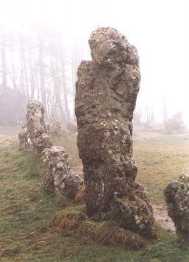

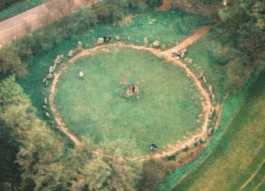
Photos by Andy Burnham @ www.megalithic.co.uk
Old Charles Walton had lived in the area all his life and while he wasn’t particularly popular, he was well known in the community as a recluse. Some regarded him as eccentric while others viewed him with suspicion, albeit with respect. Walton was widely known to be clairvoyant and was said to hold particular powers over animals. He was well versed in country lore and knew much about the old ways of the countryside. It was generally accepted that he was involved with various covens operating in the area.
Some claimed he could talk to the birds and direct them to go where he willed simply by pointing his finger. They also claimed he could control other animals, all except dogs which he feared. His hobby was breeding large toads of a type they call “Natterjack”. Natterjacks had short hind legs and moved about by running rather than hopping. Despite all this Walton had few if any enemies and could number most of the villagers amongst his friends.
Walton’s clairvoyancy began when he was a young man. An incident occurred that would change his personality from extrovert to introvert. Having just left school Walton had started work as a ploughboy in the fields, when for three consecutive nights while on his way home he saw what he thought was a phantom black dog running around on nearby Meon Hill, a particularly bleak and Witchy place. On the third night a headless woman accompanied the dog and the following day his sister died.
Walton took this to be an omen, it frightened him and from it developed his fear of dogs. He also withdrew into himself, worked for meager wages, seldom drank in public and was soon left alone by his neighbours. Later he was rumoured to steal out at night down to Meon Hill or the Rollright Stones and there take part in Witchcraft rituals.
In 1945 Walton lived in a half-timbered thatched cottage in Lower Quinton which he rented for 3 shillings a week. He shared the cottage with his niece Edith Walton whom he had adopted as a child. Edith now acted as his housekeeper and generally looked out for his welfare. Walton had worked the local farms since he had left school and despite his 74 years still prided himself capable of a day’s work in the field. He regularly undertook to do light work whenever it was offered.
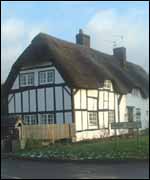
On Wednesday morning of the 14th February 1945, Walton arose early and prepared for a day in the fields. He shivered a little as he peered out his window absently rubbing circulation back into his aching rheumatic joints. The weather so far that week had not been good with lots of fog and drizzle. That day for a change it seemed to be fine except for an overnight ground frost. Just as well thought Walton for a local farmer near Meon Hill had hired him to trim some hedges. After a hearty breakfast cooked by his niece Edith, she pecked his cheek and watched as he slowly shuffled off down the lane. He walked with the aid of a walking stick carrying a pitchfork, billhook and a piece of fruitcake she had packed for his lunch slung across his right shoulder.
Shortly after Walton left for Meon Hill, Edith who worked in a local factory also left for work and didn't return until 6pm. On arriving home she soon became concerned, for Walton was not there to greet her. He was a man of old habits and always returned home at the same time each day, especially during the winter months when darker evenings made working outside difficult. Also of concern was the weather, a horrid thick fog had enveloped the area and visibility was poor particularly out in the fields. Rarely would he stop off anywhere without he first inform her, he was well aware of how she worried.
Fearing he may have taken ill or met with an accident she ran next door to her neighbour Harry Beasley. “Has Old Charles called in here?” she asked when he came to the door.
“No!” replied Beasley, and seeing how worried she was added, “Hang-on, I’ll get a coat”.
Together she and Beasley walked up to Firs Farm, Walton’s employer for that day. “Had Old Charles stopped off on his way home?” they inquired.
“No! He hasn’t”, said “Alfred Potter” the owner of Firs Farm, “last I saw him ‘twas before the fog came down” he said.
He claimed to have noticed a distant figure that morning on the hillside of Meon Hill, and had assumed it to be Walton trimming hedges. Potter now equally concerned joined Edith and Beasley. The trio carrying torches walked up the hill to the point where Walton had last been seen.
The night was heavy with silence and against their foggy surroundings the yellowish light from their torches shone eerily into the night. After a short search of the area they came across Walton's body. They found it lying face up beneath a willow tree on top of Meon Hill. It was a particularly gruesome find for Walton had been brutally murdered with his own pitchfork. The pitchfork had been driven through his throat with such force it had nearly severed his head and pinned to the ground the prongs of the fork had embedded nearly six inches. A large cross-shaped wound had been slashed deeply into his chest with the billhook which had then been left stuck into his ribs. Walton’s face was contorted with terror and blood from his wounds had soaked into the ground all around his body.
The Police were immediately summoned and such had been the ferocity of the attack, it took two constables to remove the pitchfork from the ground and body. Walton’s mutilated body was carried down the hill into the village and a major Police investigation began. Superintendent Alec Spooner of the Warwickshire CID led the initial the inquiry. News of the murder began to spread and such was the level of public interest in the crime Scotland Yard was called in to take over the investigation.

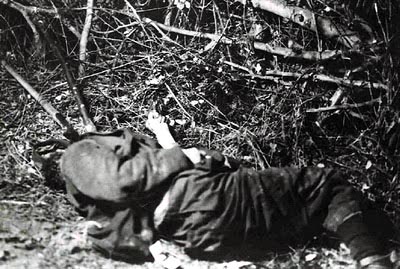
Detective Superintendent Robert Fabian the most famous Police Officer of the day, together with his assistant Sergeant Albert Webb traveled up from London on the night train. The following day they met with Spooner and started to co-ordinate the hunt for the killer. After discussing the various points of the murder they began to speculate as to the nature of the person who had committed the crime. Sergeant Webb a hardened and experienced London Officer suggested that it was the work of a manic psychopath, after all he said who else would attack and mutilate a defenseless old farm worker?
Fabian tended to agree but Spooner who had lived and worked in the area for most of his life, and who was well versed in the area’s beliefs and practices wasn’t convinced, he had already been doing some research. He produced a book that was to give the crime an entirely new and different angle. The book was called “Folklore, Old Customs and Superstitions in Shakespeare Land” written by J. Harvey Bloom a local vicar in 1929. Spooner had underlined a passage which told how in 1875 "... a weak minded young man had killed a woman named Ann Turner. He had killed her using a pitchfork because he believed she had bewitched him".
Further on in the book he had marked another page. This told how in 1885 a young ploughboy by the name of “Charles Walton” had encountered a large black dog on three successive days while on his way home from work. On the last occasion a headless woman accompanied the dog. Legends and superstitions about black dogs were not rare, especially in rural areas and there had long been stories of a ghostly black dog on Meon Hill. It supposedly heralded death to those it appeared to. But was it possible that this “Charles Walton” was the same person asked Spooner?
Spooner then handed Fabian another book “Warwickshire” published in 1906. The author Clive Holland another local man, described the murder of Ann Turner in greater detail. He included an account of the trial of John Hayward, who was eventually found guilty of the crime and hanged. In his defense Hayward stated that he considered he was acting for the good of the whole community. Ann Turner had allegedly "bewitched the cattle and land of local farmers". He said that he had "pinned her to the ground with a pitchfork before slashing her chest with a billhook in the form of a cross". Holland explained that this was the ancient and traditional way of killing a Witch and that this was the only way to prevent a dead Witch rising from the grave.
Fabian and Webb accustomed as they were to the evil that exists in men, and the actions they were capable of perpetrating against others, still felt a shiver as they listened to Spooner. The similarities between the two cases were obvious but whatever their private thoughts, they considered themselves professionals and with the eyes of the nation upon them they wanted proof not superstition to account for the murder. They resolved themselves to finding a 20th Century criminal.
An incident room was set up at Stratford-upon-Avon Police Headquarters and Fabian began his investigation. An aircraft from nearby RAF Leamington Spa was flown over the site of the murder and detailed photographs were taken of the whole area. Some of these still exist (see above) but being in black and white they unfortunately didn't reveal anything of use to the police.
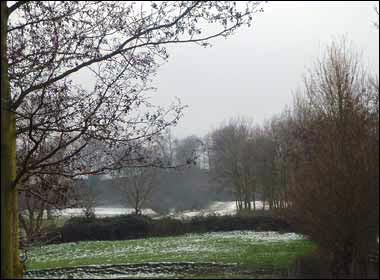
The next step was a ground search carried out by local police officers, they also called in soldiers from the Royal Engineers with metal detectors. In particular they were looking for Walton’s pocket watch for it had been discovered missing from his waistcoat. Fabian thought this unusual as the watch was a cheap one made of tin, 'hardly worth taking let alone murdering for' he thought, but still, if it could be found he hoped it would bear the fingerprints of the killer. Despite an intensive search of the area and a finger tip search of Walton’s home, the watch was never located.
The 493 inhabitants of the village all received a visit from Fabian and Webb, and all were asked to account for their movements on the day of the murder. At Police HQ Fabian had set up a large map on the wall of his office and all the suspects were marked on it with pins so he could track their movements. Within days they made an arrest. It was an Italian prisoner of war from a nearby internment camp at Long Marston. He had been caught hiding in a ditch on Meon Hill with blood stains on his hands. After intensive questioning however, it transpired that the man was merely a poacher who had regularly escaped from the camp to supplement his diet with a few rabbits. He was returned to the camp without charge and the search continued.
Fabian next turned his attention to Alfred Potter the farmer who had employed Walton, for he appeared to have been the last person to see Walton alive. Potter claimed he had been working in his own fields that morning and estimated that he had seen Walton on the hillside at around 2pm. He assumed it was Walton because nobody else should have been on his land cutting hedges. In his statement he described Walton as wearing shirtsleeves, but when the body was found Walton was wearing a sleeveless work shirt. Had Potter seen the killer or was he merely mistaken?
Despite all their efforts to catch the killer, their inquiry was beginning to lose its momentum. Over 4,000 statements had been taken and anyone traveling or visiting the area had been traced and interviews conducted as far away as Somerset and Yorkshire. Using the most modern techniques available to forensic science, samples of hair and clothing from the murder scene had been exhaustively analyzed but none had produced positive results. All other lines of enquiry had been followed and explored and yet the murderer was no nearer to being caught.
Fabian reluctantly turned his attention to the witchcraft theory and with the aid of Spooner’s knowledge and experience began to delve into the area’s history and folklore. He discovered that according to the old Julian calendar in use until the Middle Ages, February 14th actually fell on February 2nd, which according to local superstition was traditionally the best day for a blood sacrifice. At this point in the year the earth is just beginning to recover from the winter and last harvest. In times of old the ancient Druids believed that as the life force of the earth had been taken out, so to it must be returned ready for the new crops. They would then make a blood sacrifice to ensure a good harvest would follow. The crops of 1944 had been poor and the spring crops for 1945 didn’t look promising either. 'Had Walton been made the ultimate sacrifice', wondered Fabian?
In the meantime Spooner had picked up on a rumour that Walton had been known to harness his large toads to toy ploughs and send them out running in the fields blasting the crops. Blasting is an old Witches method of effecting nature and could be used to improve or destroy the fertility of crops. In 1662 a Scottish Witch called Isobel Gowdie confessed to doing the same and claimed to have destroyed the crops of a neighbour by blasting. Perhaps someone thought Walton was using witchcraft to blast his neighbour’s crops? What was significant Spooner pointed out, was that Walton’s blood had been allowed to drain into the ground all around him, and according to old beliefs, blooding or the draining of a witches blood could neutralize the Witch’s power after death.
As Fabian pursued this line on witchcraft he found a general reluctance amongst the local people to talk about it. One man in particular even expressed the sentiment that 'Walton was dead and buried so there was nothing else to worry about'. The probability that Walton had played the leading role in some sort of fertility sacrifice, seemed to Fabian unlikely and faced with the barrage of silence from anyone he questioned about it, he decided to look elsewhere.
His last line of enquiry was that of Walton's past, but aside from his eccentricity nothing out of the ordinary was found except for the strange disappearance of his money. In 1927 Walton's wife had died and left him in a Will the sum of £297.00, quite a considerable amount in those times. He was known to have placed it in a building society but when the Police investigated, the balance of his account was only £2 11s 9d. Walton had been a frugal man and was not given to overindulgence. He had worked all his life and his earnings easily covered his weekly out-going’s, this was estimated at no more than £2 per week plus his rent. Some 60 shillings were all that was found in his house after his death, the remainder was never accounted for and no explanation has ever given for its disappearance.
As the inquiry drew to a close Fabian took one last walk up the hill to the site of the murder. "It was a bleak and lonely place" he recorded later in his memoirs. As he looked around a large black dog ran past him. Shortly afterwards a young boy came up the hill and Fabian asked him whether he had lost his dog. When the boy looked puzzled he explained that he'd just seen a large black dog go by, at which the boy gasped, turned and ran as fast as he could back down the hill. Later that day a large black dog was ran over and killed by a police car in a lane near the village. The following morning a heifer was found to have died in a ditch nearby.
Their inquiries exhausted Fabian and Webb returned to
London, no closer to finding the murderer than when they had begun.
The inquest on Charles Walton gave the cause of death as "Murder by
Person or Persons Unknown"; he was then buried in the churchyard at Lower
Quinton. The churchyard has since
been re-landscaped and its old headstones removed.
So today there is no trace left of Old Charles Walton.
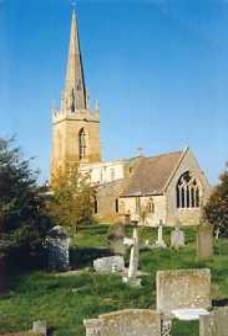 The
church with its tall steeple is dedicated to St Swithin (best known perhaps for
his supposed influence on the weather). It is a landmark for many miles
around and represents many styles of architecture. Worthy of note in the
inside is the effigy of a knight, recumbent beneath an arch in the south
aisle. He is Sir William Clopton a wealthy landowner with estates in four
counties and the Welsh Marches. When he died his wife took a vow of
perpetual widowhood and lived for the remainder of her life as an anchorite in a
cell near to the church. The windows bearing heraldic arms are by Geoffrey
Webb, who is also the artist of the window in the south aisle called 'The
Children’s Window'. This is the result of a visit to the local school by
the artist, who asked the pupils to name their favourite birds and insects,
these he portrayed in the window togeather with pixies nominated by other young
scholars. The earliest church register dates from 1547 and includes the
year 1556 when because of smallpox there were 58 burials, about one quarter of
the entire village population died at that time.
The
church with its tall steeple is dedicated to St Swithin (best known perhaps for
his supposed influence on the weather). It is a landmark for many miles
around and represents many styles of architecture. Worthy of note in the
inside is the effigy of a knight, recumbent beneath an arch in the south
aisle. He is Sir William Clopton a wealthy landowner with estates in four
counties and the Welsh Marches. When he died his wife took a vow of
perpetual widowhood and lived for the remainder of her life as an anchorite in a
cell near to the church. The windows bearing heraldic arms are by Geoffrey
Webb, who is also the artist of the window in the south aisle called 'The
Children’s Window'. This is the result of a visit to the local school by
the artist, who asked the pupils to name their favourite birds and insects,
these he portrayed in the window togeather with pixies nominated by other young
scholars. The earliest church register dates from 1547 and includes the
year 1556 when because of smallpox there were 58 burials, about one quarter of
the entire village population died at that time.
Long after the case was forgotten Superintendent Alec Spooner continued his own personal hunt for the killer. He remained convinced that the killer was a local man and he soon became a familiar figure in the village. Every year on the anniversary of the murder Spooner would revisit, climb to the scene of the crime and then later walk around the village hoping to find a clue that may have been missed. Even after his retirement from the force he continued to visit the village in the hope that one day the killer would make a mistake and give himself away.
It may seem to the residents of Upper and Lower Quinton that the murder of Walton will never completely disappear, for a strange postscript to the crime occurred in August 1960. During the modernization of Walton's cottage and the demolition of the old outhouses a workman saw something shinning in the gloom, picking it up he found it to be an old tin pocket watch. It was later identified as the watch that Walton was wearing on the day of his death.
On opening the watchcase they found inside a small piece of colored glass. Walton was known to have carried this around with him never letting it out of his possession. It was his talisman and he is thought to have used it to reflect and absorb any evil thoughts directed at him. It’s a common belief that such a talisman if lost or misplaced, would eventually find its way back to its owner. The odd thing about this find is that the police had thoroughly searched all the building shortly after the crime and found nothing. Had the murderer returned at some point to replace it? If so, why had he felt it necessary to return the watch when he could so easily have disposed of it by other means?
At that time in 1945 the crime attracted mass media attention, not only because of the brutality of the crime, but also as a relief from war time reporting issues which dominated most newspapers. It also drew the attentions of some of the countries celebrated writers and occultists including Margaret A. Murray the eminent anthropologist and pioneering writer on Witchcraft. Murray spent a week in the area disguised as an artist unobtrusively conducting her own investigation. She later publicly stated that she believed Walton had been killed because of local belief in witchcraft.
Despite the efforts of all the various writers, journalists and investigators throughout the years, we are still no closer to finding the killer than “Fabian of the Yard” had been in 1945. Today the file on the murder of Charles Walton remains open, and in Warwickshire Police archives it is still possible to see the weapons used to commit the crime. When visiting the village today one cannot help but notice that the older inhabitants are still reluctant to talk about death of Old Charles Walton. Whatever the truth is the events of St. Valentine's Day on the 14th February 1945 is certain to intrigue people for many years to come.
![]()
The Encyclopedia of Witches &Witchcraft - by Rosemary Ellen Guiley
An ABC of Witchcraft Past and Present - By Doreen Valiente
Reading Central Library - Newspaper Archives
Met Office - National Meteorological Archive
Especial thanks to “Alan Grimstead”, of the Warwickshire Police Department for his kind help in finding the original crime scene photos.
www.whitedragon.org.uk/articles/charles.htm
First published on the 23rd June 2001, 18:15:20 © George Knowles

Let there be peace in the world - Where have all the flowers gone?
My Personal Page / My Place in England, UK / My Family Tree (Ancestry)
Wicca/Witchcraft / What is Wicca / What is Magick
Traditional Writings:
Wiccan Rede / Charge of the Goddess / Charge of the God / The Three-Fold Law (includes The Law of Power and The Four Powers of the Magus) / The Witches Chant / The Witches Creed / Descent of the Goddess / Drawing Down the Moon / The Great Rite Invocation / Invocation of the Horned God / The 13 Principles of Wiccan Belief / The Witches Rede of Chivalry / A Pledge to Pagan Spirituality
Correspondence Tables:
Incense / Candles / Colours / Magickal Days / Stones and Gems / Elements and Elementals
Traditions Part 1 - Alexandrian Wicca / Aquarian Tabernacle Church (ATC) / Ár Ndraíocht Féin (ADF) / Blue Star Wicca / British Traditional (Druidic Witchcraft) / Celtic Wicca / Ceremonial Magic / Chaos Magic / Church and School of Wicca / Circle Sanctuary / Covenant of the Goddess (COG) / Covenant of Unitarian Universalist Pagans (CUUPS) / Cyber Wicca / Dianic Wicca / Eclectic Wicca / Feri Wicca /
Traditions Part 2 - Gardnerian Wicca / Georgian Tradition / Henge of Keltria / Hereditary Witchcraft / Hermetic Order of the Golden Dawn (H.O.G.D.) / Kitchen Witch (Hedge Witch) / Minoan Brotherhood and Minoan Sisterhood Tradition / Nordic Paganism / Pagan Federation / Pectic-Wita / Seax-Wica / Shamanism / Solitary / Strega / Sylvan Tradition / Vodoun or Voodoo / Witches League of Public Awareness (WLPA) /
Gods and Goddesses (Greek
Mythology) / Esbats &
Full Moons / Links
to Personal Friends & Resources / Wicca/Witchcraft
Resources / What's a spell? /
Circle Casting and
Sacred Space / Pentagram
- Pentacle / Marks
of a Witch / The Witches
Power / The Witches Hat
/ An
esoteric guide to visiting London / Satanism
/ Pow-wow
/ The
Unitarian Universalist Association / Numerology: Part 1
/ Part 2 / Part
3 / A
history of the Malleus Maleficarum: includes: Pope
Innocent VIII /
The
papal Bull /
The
Malleus Maleficarum /
An extract from the Malleus Maleficarum
/ The letter of approbation
/ Johann
Nider’s Formicarius /
Jacob
Sprenger /
Heinrich Kramer /
Stefano Infessura
/ Montague Summers /
The Waldenses
/ The Albigenses
/
The Hussites / The
Sun Dance
/ Shielding (Occult
and Psychic Protection) /
Sabbats in History and Mythology / Samhain (October 31st) / Yule (December 21st) / Imbolc (February 2nd) / Ostara (March 21st) / Beltane (April 30th) / Litha (June 21st) / Lughnasadh (August 1st) / Mabon (September 21st)
Rituals contributed by Crone: Samhain / Yule / Imbolc / Ostara / Beltane / Litha / Lammas / Mabon
Tools of a Witch / The Besom (Broom) / Poppets and Dolls / Pendulums / Cauldron Magick / Mirror Gazing
Animals in Witchcraft (The Witches Familiar) / Antelope / Bats / Crow / Fox / Frog and Toads / Goat / Honeybee / Kangaroo / Lion / Owl / Phoenix / Rabbits and Hares / Raven / Robin Redbreast / Sheep / Spider / Squirrel / Swans / Wild Boar / Wolf / Serpent / Pig / Stag / Horse / Mouse / Cat
In Worship of Trees - Myths, Lore and the Celtic Tree Calendar. For descriptions and correspondences of the thirteen sacred trees of Wicca/Witchcraft see the following: Birch / Rowan / Ash / Alder / Willow / Hawthorn / Oak / Holly / Hazel / Vine / Ivy / Reed / Elder. Also see: The Willow Tree (Folk Music)
Mystical Sacred Sites - Stonehenge / Glastonbury Tor / Malta - The Hypogeum of Hal Saflieni / Avebury / Cerne Abbas - The Chalk Giant / Ireland - Newgrange /
Rocks and Stones:
Stones - History, Myths and Lore
Articles contributed by Patricia Jean Martin: / Apophyllite / Amber / Amethyst / Aquamarine / Aragonite / Aventurine / Black Tourmaline / Bloodstone / Calcite / Carnelian / Celestite / Citrine / Chrysanthemum Stone / Diamond / Emerald / Fluorite / Garnet / Hematite / Herkimer Diamond / Labradorite / Lapis Lazuli / Malachite / Moonstone / Obsidian / Opal / Pyrite / Quartz (Rock Crystal) / Rose Quartz / Ruby / Selenite / Seraphinite / Silver and Gold / Smoky Quartz / Sodalite / Sunstone / Thunderegg / Tree Agate / Zebra Marble
Wisdom:
Knowledge vs Wisdom by Ardriana Cahill / I Talk to the Trees / Awakening / The Witch in You / A Tale of the Woods
Articles and Stories about Witchcraft:
Murder by Witchcraft / The Fairy Witch of Clonmel / A Battleship, U-boat, and a Witch / The Troll-Tear (A story for Children) / Goody Hawkins - The Wise Goodwife / The Story of Jack-O-Lantern / The Murder of the Hammersmith Ghost / Josephine Gray (The Infamous Black Widow) / The Two Brothers - Light and Dark
Old Masters of Academia:
Pliny the Elder / Hesiod / Pythagoras
Abramelin the Mage / Agrippa / Aidan A. Kelly / Albertus Magnus “Albert the Great” / Aleister Crowley “The Great Beast” / Alex Sanders "the King of the Witches” / Alison Harlow / Amber K / Anna Franklin / Anodea Judith / Anton Szandor LaVey / Arnold Crowther / Arthur Edward Waite / Austin Osman Spare / Biddy Early / Bridget Cleary / Carl Llewellyn Weschcke / Cecil Hugh Williamson / Charles Godfrey Leland / Charles Walton / Christina Oakley Harrington / Damh the Bard (Dave Smith) / Dion Fortune / Dolores Aschroft-Nowicki / Dorothy Morrison / Doreen Valiente / Edward Fitch / Eleanor Ray Bone “Matriarch of British Witchcraft” / Dr. John Dee and Edward Kelly / Dr. Leo Louis Martello / Eliphas Levi / Ernest Thompson Seton / Ernest Westlake and the Order of Woodcraft Chivalry / Fiona Horne / Friedrich von Spee / Francis Barrett / Gerald B. Gardner / Gavin and Yvonne Frost and the School and Church of Wicca / Gwydion Pendderwen / Hans Holzer / Helen Duncan / Herman Slater "Horrible Herman" / Israel Regardie / James "Cunning" Murrell / Janet Farrar & Gavin Bone / Jessie Wicker Bell “Lady Sheba” / John Belham-Payne / John George Hohman / John Gerard / John Gordon Hargrave (the White Fox) / John Michael Greer / John Score / Johannes Junius the Burgomaster of Bamberg / Joseph John Campbell / Karl von Eckartshausen / Laurie Cabot "the Official Witch of Salem" / Lewis Spence / Margaret Alice Murray / Margot Adler / Marie Laveau the " Voodoo Queen of New Orleans" / Marion Weinstein / Matthew Hopkins “The Witch-Finder General” / Max Ehrmann and the Desiderata / Monique Wilson the “Queen of the Witches” / Montague Summers / Nicholas Culpeper / Nicholas Remy / M. R. Sellers / Mrs. Grieve "A Modern Herbal" / Oberon and Morning Glory Zell-Ravenheart / Old Dorothy Clutterbuck / Old George Pickingill / Paddy Slade / Pamela Colman-Smith / Paracelsus / Patricia Crowther / Patricia Monaghan / Patricia “Trish” Telesco / Philip Emmons Isaac Bonewits / Philip Heselton / Raymond Buckland / Reginald Scot / Robert Cochrane / Robert ‘von Ranke’ Graves and "The White Goddess" /
Rudolf Steiner / Rosaleen Norton “The Witch of Kings Cross” / Ross Nichols and The Order of Bards, Ovates & Druids / Sabrina - The Ink Witch / Scott Cunningham / Selena Fox / Silver Ravenwolf / Sir Francis Dashwood / Sir James George Frazer / S.L. MacGregor Mathers and the “Hermetic Order of the Golden Dawn” / Starhawk / Stewart Farrar / Sybil Leek / Ted Andrews / The Mather Family - includes: Richard Mather, Increase Mather, Cotton Mather / Thomas Ady / Vera Chapman / Victor Henry Anderson / Vivianne Crowley / Walter Brown Gibson / William Butler Yeats / Zsuzsanna Budapest
Many of the above biographies are brief and far from complete. If you know about any of these individuals and can help with aditional information, please cantact me privately at my email address below. Many thanks for reading :-)
While I have taken due care and dilligence to credit all sources where possible, this website may contain copyrighted material which has not been specifically authorized by the copyright owner. My use of making such material available here is done so in my efforts to advance our understanding of religious discrimination, the environmental and social justice issues etc. If you wish to use copyrighted material from this wedsite for purposes of your own then you must obtain permission from the relevant copyright owner yourself.
![]()
My online email discussion group:
http://groups.yahoo.com/group/Email_Witches

Help send a message of peace around the world! The Dove of Peace flies from site to site, through as many countries as possible. It does not belong to ANY belief system. Please help make a line around the globe by taking it with you to your site, by giving it to someone for their site, by passing it on to another continent or to the conflict areas of the world. May trouble and strife be vanquished in it's path.

mailto:George@controverscial.com
![]()
|
|